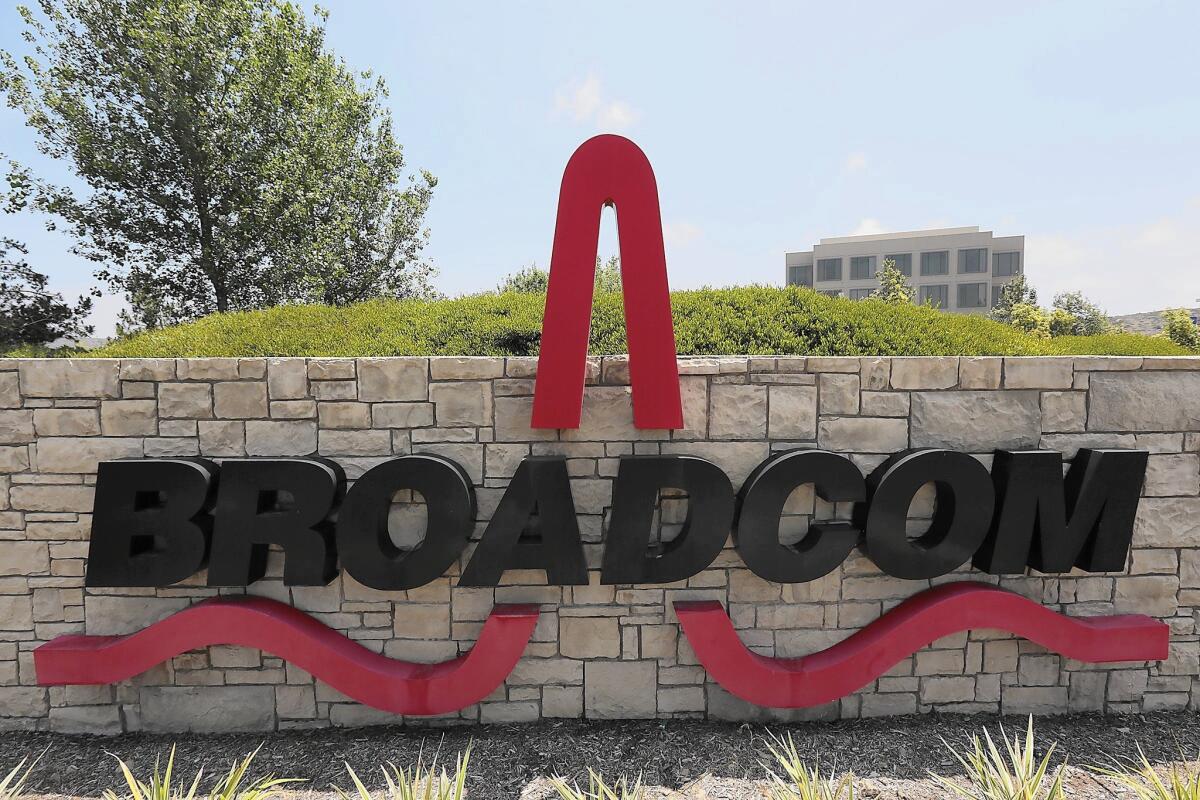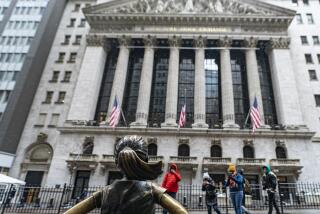Corporate mergers and acquisitions are on a record pace this year

Broadcom Corp., the Irvine chip maker, has agreed to be bought by rival Avago Technologies Ltd. for $37 billion. The deal is not even in the top 10 global mergers announced this year.
- Share via
In late May, Broadcom Corp. announced stunning news: The giant Irvine chip maker would be bought by rival Avago Technologies Ltd. for $37 billion in one of the largest tech deals in history.
Six months later, the Avago-Broadcom tie-up doesn’t even rank among the top 10 global corporate mergers announced this year.
Corporate mergers and acquisitions this year are on pace to break the record of $4.6 trillion set in 2007, according to Dealogic, which tracks the market.
“El Niño came early to the M&A market because it’s been raining deals all year long,” said Lloyd Greif, chief executive of Greif & Co., an investment bank in Los Angeles.
As with Avago and Broadcom, the takeover craze largely is being driven by companies looking for acquisitions in the same industry, or close to it, so that they can gain market share, new products and geographic reach in sectors where they already compete.
That’s the case in the largest deal announced so far this year: Anheuser-Busch InBev’s plan to buy SABMiller for $105.6 billion, combining two of the world’s largest beer makers.
The same trend is playing out in healthcare, oil and gas, technology, telecommunications, aerospace, home building and food products. Healthcare, in particular, has seen a spree of takeovers as providers, insurers, pharmaceutical makers and drugstores reposition themselves for industry changes spawned by the federal Affordable Care Act.
The law is “causing a lot of refocusing and reordering of companies’ business models,” said Jeff Greene, who leads the life-sciences mergers and acquisitions practice at Ernst & Young.
Among other deals, Anthem Inc. is buying rival health insurer Cigna Corp. for $51.9 billion, and drugstore chain Walgreens Boots Alliance Inc. agreed last month to acquire competitor Rite Aid Corp., for $9.4 billion.
The biggest deal in healthcare this year might be yet to come: Drug giant Pfizer Inc. has acknowledged that it’s looking at buying Botox maker Allergan, and the potential purchase price based on Allergan’s current stock value could exceed $120 billion.
Many companies also are eager to buy, or be sold, because the economy and corporate sales and profits are growing slowly and acquisitions help them kick-start additional growth.
Whether the deals end up benefiting employees, consumers and suppliers is another matter. Each transaction is different, but often an immediate goal is to eliminate the combined companies’ redundant functions — especially on administrative staffs — and that means job cuts.
In the case of healthcare, critics also are concerned that as the number of players in each sector shrinks, consumers will have fewer choices and prices will rise. The possible Pfizer-Allergan deal drew such criticism amid the ongoing debate about higher drug prices.
Merger history also has no shortage of deals that failed to live up to their hype or were outright flops, most notably Time Warner’s ill-fated purchase of AOL in 2001 for $147 billion.
A company’s desire to buy another is one thing; ability is another. This year companies have been able to strike such a massive number of deals for several reasons.
With interest rates still low, businesses can borrow relatively cheaply to finance takeovers. The stock market, despite severe bumps late this summer and last week, remains at near record-high levels, and that gives buyers a strong currency to help pay for deals.
Also, “companies got lean during the recession and during that time they accumulated cash” they can now use for acquisitions, Greif said.
Waves of mergers aren’t new, of course. They’re part of what economist Joseph Schumpeter once called the “creative destruction” that constantly occurs as businesses evolve. But the merger cycles have had changing goals.
A few decades ago, for instance, the trend was for companies to diversify, and they bought a hodgepodge of disparate businesses with the thinking that one line would do well when another faltered as the economy kept changing.
That gave rise to so-called conglomerates such as Teledyne Inc., ITT Corp. and General Electric Co. Eventually their attraction ebbed as companies turned their focus to being more efficient and nimble in specific areas, in large part because they faced increasing global competition.
That trend continues. GE, for instance, announced this spring that it would sell most of its GE Capital finance division.
Some conglomerates remain, notably billionaire Warren Buffett’s Berkshire Hathaway Inc., and Buffett this summer announced his largest deal yet. His company agreed to pay $32 billion for Precision Castparts Corp., a maker of parts and equipment with 5,000 employees in Southern California.
But most of this year’s deals have been strategic, a way for companies to enhance their sales and profits in their primary fields. Case in point: Aerospace giant Lockheed Martin Corp. bought helicopter maker Sikorsky Aircraft Corp. this year for $9 billion.
This year’s merger wave is all about “corporate managements that see opportunities to extend their footprints and expand their market shares, and acquisitions are one way to do that,” said Richard Peterson, a senior director at the research firm S&P Capital IQ.
He and others also believe the merger wave will not slow markedly any time soon, barring a major shock to the economy or financial system, because the factors fueling the takeovers remain in place.
Indeed, they noted that private-equity firms that specialize in acquiring companies have been relegated to being secondary players in the current merger wave, which has been dominated by corporations seeking strategic partners.
Yet there is still $500 billion in global buyout funds waiting to be used, what Peterson calls “dry powder” that could help sustain the record pace of merger activity well into next year.
“I think we’re at a top” in terms of the merger wave, Greif said. “But I don’t see anything in the near term that would cause me to say it’s going to end.”
Twitter: @PeltzLATimes
More to Read
Inside the business of entertainment
The Wide Shot brings you news, analysis and insights on everything from streaming wars to production — and what it all means for the future.
You may occasionally receive promotional content from the Los Angeles Times.











